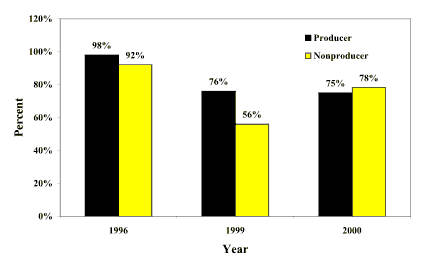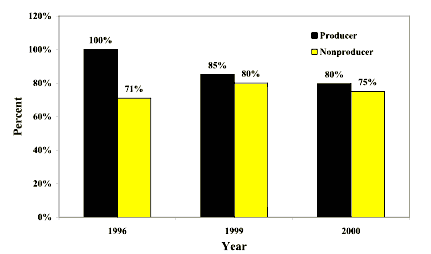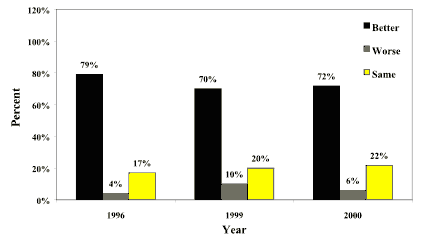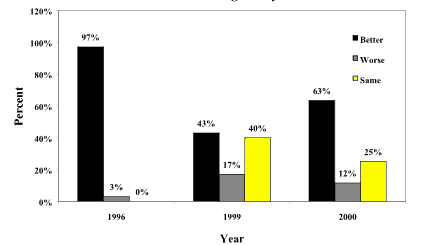August 2002 // Volume 40 // Number 4 // Research in Brief // 4RIB2
Gauging Perceptions of Farm Programs
Abstract
As the 2002 Farm Security and Rural Investment Act (FSRI) is implemented
and producers and others in agribusiness more fully understand its impacts
on agriculture, it will be increasingly important to monitor their perceptions
of FSRI. We present survey results from Kansans who attended an annual Extension
conference regarding their attitudes towards the Federal Agricultural Improvement
and Reform Act (FAIR). Results indicate that respondents generally had positive
views of FAIR and were favorable to retaining some elements of FAIR in new
agricultural policy. Extension educators have the responsibility to compile
similar information during the crop years covered under FSRI.
Introduction
After considerable debate, the Farm Security and Rural Investment Act (FSRI) was enacted in May 2002, replacing the 1996 Federal Agricultural Improvement and Reform Act (FAIR). The scope and complexity of the new farm legislation suggests that Farm Service Agency (FSA) and other U.S. Department of Agriculture (USDA) agencies have a large task of creating regulations to implement FSRI and educating producers of the provisions, alternatives, and benefits available to them under FSRI.
As in the past, Extension will likely be a key player in developing and delivering educational programs and decision-making tools related to the farm program. Extension personnel can use various educational opportunities and programs to not only explain the provisions of FSRI, but also to gather information regarding producers' perceptions of how farm policy affects, or is expected to affect, their operations. This latter information can be especially useful to policy makers as they assess the implementation of new farm policy and consider changes for the next farm bill.
The marked change in agricultural policy in 1996 fostered immediate interest in the impacts of FAIR on farm income, income variability, land values, crop acreage mixes, and producer perceptions of federal agricultural policy. By the end of FAIR in 2001, producer assessments of these impacts changed as a result of historically low commodity prices that occurred from 1998 to 2001, underscoring the importance of continually monitoring the effects of farm policy. Observing changes in producers' and nonproducers' views of FAIR was useful for policy makers as they considered which components of FAIR, if any, should be incorporated into FSRI.
In this report, we demonstrate how the perceptions of FAIR and its impacts on income and income variability changed from 1996 to 2000 for a small and nonrandom sample of Kansas producers and agribusiness professionals. This information, combined with other similar observations from other studies, was beneficial for legislators as they framed FSRI, which retained some of the program benefits provided in FAIR (e.g., fixed payments). Similarly, tracking producer and nonproducer perceptions and observed effects of FSRI will be useful to policy makers and agricultural interest groups as they monitor FSRI and propose new policy to replace it when it expires in 2007.
Background
Adoption of FSRI in 2002 replaced the 1996 FAIR act; however, some components of FAIR and the 1990 farm program were incorporated into FSRI. FAIR was designed to separate income support payments from commodity prices. Under FAIR, a one-time sign-up allowed producers planting flexibility in return for fixed annual payments that declined annually through 2002. Low commodity prices in 1998 through 2001 (which were largely unexpected in 1996 when FAIR was enacted) prompted additional emergency supplemental payments and loan deficiency payments (LDP). The 1990 farm program, which required farmers to follow a historical planting pattern and occasionally divert acres from production, included nonrecourse government loans using the program crop as collateral and deficiency payments, which covered the difference between a program crop's established target price and the higher of the loan rate or national average market price.
FSRI provides for three types of payments on covered commodities: marketing assistance loans, direct payments, and counter-cyclical payments. Each of these retain elements of the 1996 and 1990 farm programs, with some notable exceptions:
- Marketing assistance loan and LDP rates (carried over from FAIR) are higher
for all commodities from 2002 to 2007, the years covered by FSRI. Rates are
highest for the first 2 years of FSRI and are reduced for the 2004 to 2007
crop years.
- Direct payments made available under FSRI are administered similar to fixed
payments under FAIR; however, direct payment rates do not decline over the
life of the program and are decoupled from production and price. Direct payment
rates are somewhat higher than what FAIR fixed payments would have been in
2002.
- Although counter-cyclical payments are similar to the deficiency payments made under the 1990 farm program, FSRI counter-cyclical payments are based on previous production history. (Deficiency payments with the 1990 farm program were made based on current production.)
Policy makers' decision to retain elements of previous farm programs, with modification, in the 2002 farm program was based, at least partially, on producer preferences for those elements and their perception of how they would benefit from the program as their operations changed in the future. Other producer and public attitudes and perceptions were also incorporated into FSRI:
- Program payment benefits have become more decoupled from price and/or production (e.g., direct and counter-cyclical payments).
- Soybeans, and as well as some other minor oilseeds, have been included as program crops in FSRI.
- More benefits for conservation practices have become available through expansion of existing conservation programs and creation of new programs.
Because farm policy is created with consideration given to producers' and agribusiness persons' perceptions, it is important to gather such information. Extension personnel are often in a good position to do this.
Gathering Perceptions on Farm Policy
In an effort to ascertain perceptions of FAIR among Kansas producers and agribusiness professionals, attendees of the annual Kansas State University (KSU) Risk and Profit Conference were surveyed in 1996, 1999, and 2000 regarding current and future agricultural policy. This intensive 2-day conference generally attracts producers from relatively large and well-managed farms and agribusinesses leaders in Kansas and surrounding states. Survey respondents were classified as producers or nonproducers according to their principal occupation and primary source of income (on-farm production or off-farm employment and investments). Producers' operations tended to be wheat, corn, grain sorghum, soybean, and hay enterprises. Nonproducers were employed as bankers, lenders, Extension educators, appraisers/brokers, and consultants.
In 1996, producers accounted for nearly 60% of 92 returned surveys. In 1999, 146 participants responded to the survey, with 41% being producers. Forty-three percent of the 105 total respondents to the 2000 survey were producers. The average farm size was approximately 2,600 acres in 1999, three times the Kansas average farm size of 748 acres. The mix of occupations among the nonproducer group was similar across years. Bankers/lenders comprised approximately 40% of the group, whereas appraisers/brokers accounted for about 30% of nonproducers. Both producers and nonproducers were queried regarding their perceptions of FAIR's effect on farm income and income variability, as well as their overall rating of FAIR relative to previous farm policy and their preferences for future policy.
Perceived Effects of FAIR on Farm Income
Because FAIR substantially changed the way government payments were provided, its effects on farm income were uncertain. Attendees of the 1996 KSU Risk and Profit Conference were asked how they expected farm income to be affected by FAIR, whereas 1999 and 2000 conference attendees were asked how FAIR had changed farm income (Figure 1). Results indicate that:
- In 1996, most of the respondents perceived FAIR would increase farm income.
This reflected the substantial increase in 1996 payments under FAIR relative
to the 1990 farm bill and the freedom to plant more acres when prices increase.
- In 1999 and 2000, as fixed payments declined and commodity prices fell
to historic lows, fewer producers (76% and 75%, respectively) deemed FAIR
to have increased farm income. Without the addition of market loss assistance
payments in 1999 and 2000, this decrease would likely have been larger.
- The percent of nonproducers who thought FAIR increased farm income fell to 56% in 1999 but grew to 78% by 2000. The change in opinion is likely due to when congress passed legislation to provide additional farm aid. In 1999 this occurred in the fall (after the conference was held), and in 2000 the decision was made in the spring (prior to the conference).
Figure 1.
Percent of Respondents Perceiving FAIR Increased Farm Income

Perceived Effects of FAIR on Income Variability
The expected risk-return tradeoff suggests that if farm income increased as a result of FAIR, variability in farm income will also increase. Similar to the question for income, 1996 survey respondents indicated how they envisioned FAIR to impact income variability in the future and 1999 and 2000 respondents indicated how FAIR affected income variability (Figure 2). Results showed that:
- All producer respondents expected FAIR to increase income risk in 1996.
Fewer nonproducers (71%) expected income variability to increase due to FAIR.
- By 1999, over 80% of respondents thought that FAIR increased farm income
variability. This number declined in the 2000 survey.
- Fewer producers perceived an increase in income variability after nearly 4 years of FAIR relative to their expectations in 1996, possibly due to the large unanticipated increases in marketing loss assistance, oilseed, and other disaster payments made as a result of low commodity prices in 1998, 1999, and 2000. These supplemental government payments, when farm income would have substantially declined due to low crop prices, helped reduce farm income variability across years.
Figure 2.
Percent of Respondents Perceiving FAIR Increased Income Risk

Overall Rating of FAIR Relative to Previous Ag Policy
The adoption of FAIR represented a substantial departure from previous agricultural policy, offering producers planting flexibility in exchange for declining fixed payments. Consequently, overall reaction to FAIR during its first 5 years was somewhat mixed. In comparing FAIR to previous agricultural policy, survey results indicated:
- In 1996, 79% of producers (Figure 3) and 97% of nonproducers (Figure 4)
anticipated that FAIR would be better than previous legislation. This suggests
that at the inception of FAIR, producers were less confident that FAIR would
have a beneficial effect on their operations than nonproducers. Regardless
of the difference between the two groups, a large majority of 1996 respondents
favored FAIR relative to the 1990 legislation.
- In 2000, the fifth year of production under FAIR, only a slightly lower percentage of producers indicated approval of FAIR relative to 1996 (Figure 3), likely reflecting the distribution of federal aid packages in 1998, 1999, and 2000 that were not initially part of FAIR. FAIR's rating among nonproducers declined more substantially in 1999 and 2000, with 43% and 63%, respectively, indicating FAIR was better than previous legislation (Figure 4). The larger increase among nonproducers in 1999 in the disapproval rating for FAIR relative to the 1990 farm bill may have been due to the timing of supplemental payments and nonproducer uncertainty of the direct and indirect effects of low commodity prices on non-farm business in the agricultural sector.
Figure 3.
Producer Perceptions of FAIR Relative to Previous Ag Policy

Figure 4.
Nonproducer Perceptions of FAIR Relative to Previous Ag Policy

In 2000, 2 years before the expiration of FAIR, the KSU Risk and Profit Conference survey respondents provided their opinions on the future direction of farm policy. Reflecting the generally positive perceptions of FAIR during its first 5 years, the majority (60%) of respondents favored extending FAIR for another 5 years. Only 4% preferred returning to a farm program with base acreages and production controls. Another 4% thought farm programs should be ended altogether, and 8% wanted no formal program but disaster aid provided on an as-needed basis. Twenty-four percent offered other suggestions for future farm policy, many of which contained elements of FAIR (e.g., planting flexibility).
Conclusion
From the Extension conference survey results, it appears that Kansas producers were generally favorable to FAIR, citing planting flexibility and predictable production flexibility contract payments as beneficial to their production and financial management. Although they recognized and dealt with more income variability under FAIR, many producers also realized higher incomes. Agribusinesses also experienced important changes that affected how they served their producer clientele.
The needs and perceptions of both groups and their ability to adapt to changes in policy were useful to policy makers in the development of FSRI. As a result of producer and agribusiness perceptions and reaction to FAIR, as well as expert opinions, FSRI contains several elements of FAIR, including direct (fixed) payments and marketing assistance loans. Additionally, new conservation programs (e.g., Conservation Security Program) and program commodities (e.g., soybeans and other minor oilseeds) are provided for in FSRI, partially at the request of producers.
Although FSRI has yet to be fully implemented, it is important to consider how producers and others in agribusiness react not only to the transition between FAIR and FSRI, but also to how FSRI impacts farming operations over several years. Extension educators, through interacting with a wide variety of producers and agribusiness professionals, can gather and assimilate such information that will be useful in future policy making. Even through the use of small and nonrandom samples, producer information regarding farm policy can be useful to policy makers evaluating differences in policy impacts for farming operations of various sizes or geographic locations.
Agricultural policy in the future will likely further promote the adoption of additional food safety assurances and create or strengthen safety regulations regarding the production, handling, processing, and preparation of food. Further, there is an emerging trend toward increased funding for conservation in farm bills. Consumer reaction to supporting food safety assurance and protection of natural resources will, as a result, be important to monitor. Therefore, Extension personnel's efforts to gather data regarding consumer perceptions of agricultural policy will be increasingly necessary in the future.
